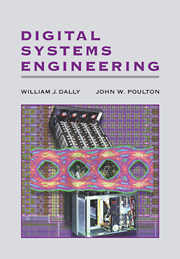Book contents
- Frontmatter
- Contents
- Preface
- Acknowledgment
- 1 INTRODUCTION TO DIGITAL SYSTEMS ENGINEERING
- 2 PACKAGING OF DIGITAL SYSTEMS
- 3 MODELING AND ANALYSIS OF WIRES
- 4 CIRCUITS
- 5 POWER DISTRIBUTION
- 6 NOISE IN DIGITAL SYSTEMS
- 7 SIGNALING CONVENTIONS
- 8 ADVANCED SIGNALING TECHNIQUES
- 9 TIMING CONVENTIONS
- 10 SYNCHRONIZATION
- 11 SIGNALING CIRCUITS
- 12 TIMING CIRCUITS
- REFERENCES
- Index
Preface
Published online by Cambridge University Press: 05 June 2012
- Frontmatter
- Contents
- Preface
- Acknowledgment
- 1 INTRODUCTION TO DIGITAL SYSTEMS ENGINEERING
- 2 PACKAGING OF DIGITAL SYSTEMS
- 3 MODELING AND ANALYSIS OF WIRES
- 4 CIRCUITS
- 5 POWER DISTRIBUTION
- 6 NOISE IN DIGITAL SYSTEMS
- 7 SIGNALING CONVENTIONS
- 8 ADVANCED SIGNALING TECHNIQUES
- 9 TIMING CONVENTIONS
- 10 SYNCHRONIZATION
- 11 SIGNALING CIRCUITS
- 12 TIMING CIRCUITS
- REFERENCES
- Index
Summary
Today we are on the brink of a major change in the way digital systems are designed. In the past, many digital designers successfully ignored electrical issues, designing their systems in terms of discrete logic. Only the designers of supercomputers and high-speed communication systems needed to look past the digital abstraction. This is no longer the case. As technology has advanced, the systems-level engineering problems of digital systems have become critical to the success of all digital systems.
As technology continues to advance, issues of signaling, timing, power, and noise become increasingly important. At high signaling frequencies, wires can no longer be considered equipotential regions and must be modeled as transmission lines. The number and speed of gates on a chip have increased faster than the number and speed of pins, making inter-chip communication a system bottleneck and placing a premium on efficient signaling and timing conventions. With reduced supply voltages and higher currents, power distribution becomes a more challenging engineering problem. At high frequencies, timing conventions must be carefully designed to prevent skew and jitter of clock signals from degrading system performance. Because of these trends, the techniques described in this book, once used only in supercomputers, are now essential to the correct and efficient operation of any type of digital system.
We were motivated to write this book for two reasons. First, in our research building high-speed digital systems (parallel computers, network switches, and high-performance graphics systems) we developed a number of signaling, timing, and power distribution techniques that overcame the limitations of conventional methods.
- Type
- Chapter
- Information
- Digital Systems Engineering , pp. xxv - xxviiiPublisher: Cambridge University PressPrint publication year: 1998

